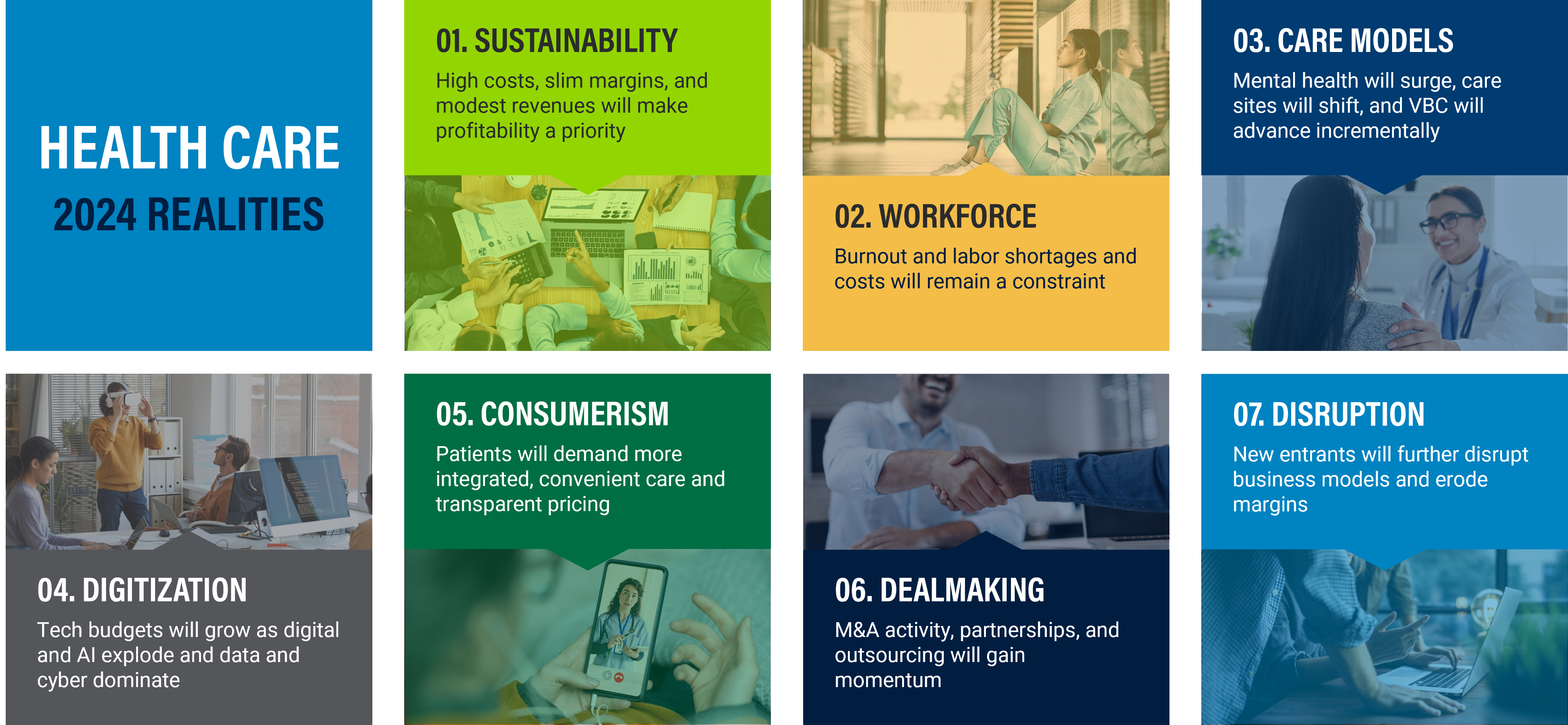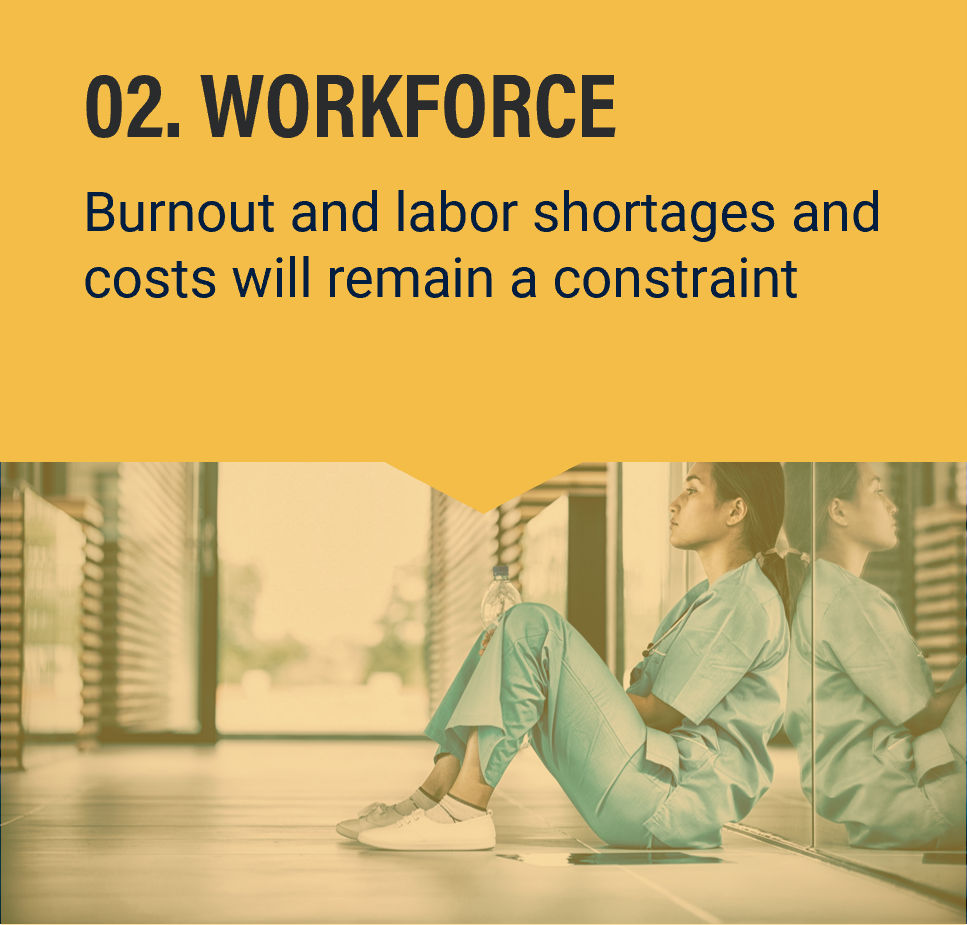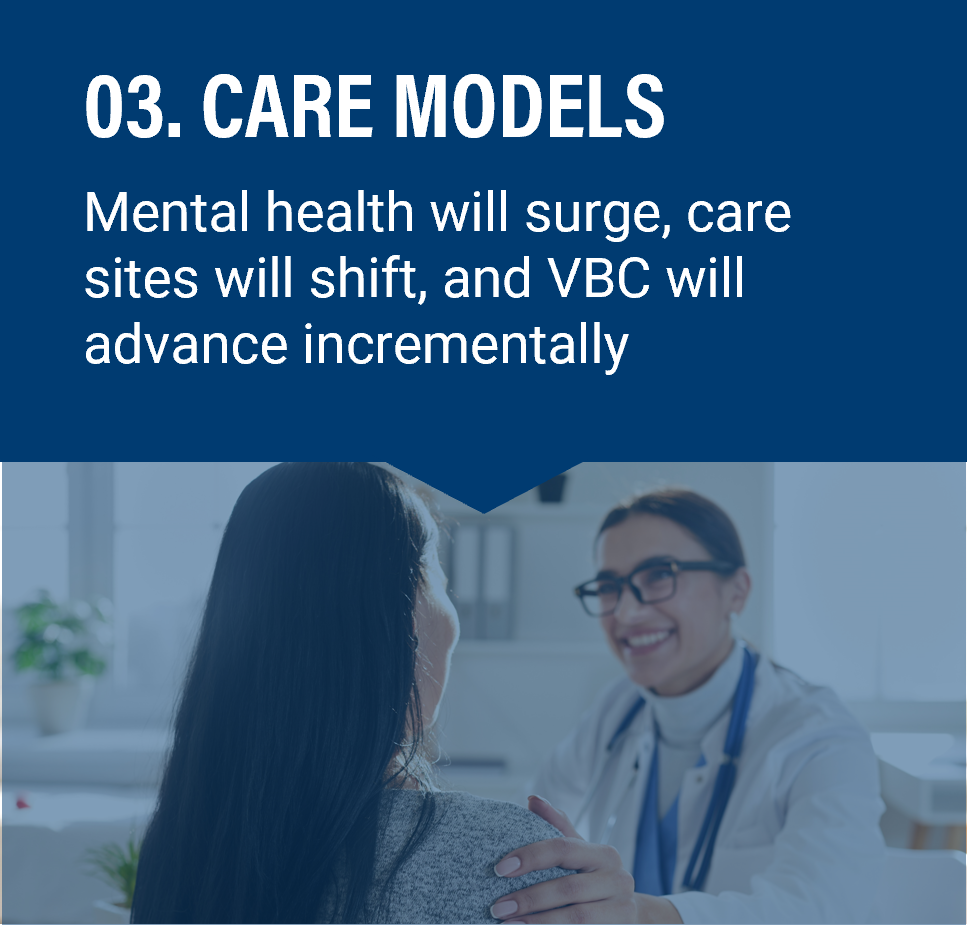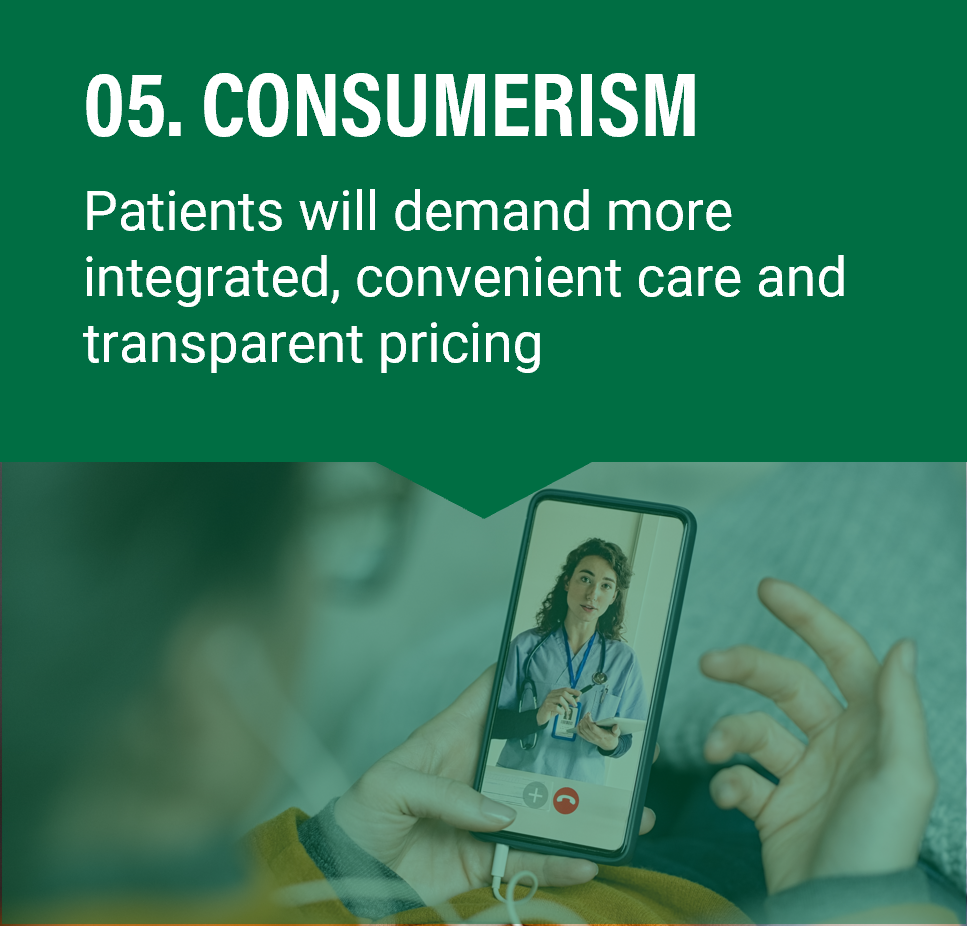Navigating Health Care Realities: Strategies for 2024 and Beyond
Published on February 12, 2024
Michael Kleinmann | Managing Director
Key Takeaway
Prevailing realities suggest a 2024 health care market that will be uncertain and uneven but with some stabilization, signaling cause for cautious optimism and continued vigilance
Actions for IT Executives
• Assess technology portfolio for alignment with organizational business strategy and priorities
• Align on metrics that matter (e.g., efficiency, resiliency, growth, consumer satisfaction, ROI, risk, or other strategic objectives)
• Rebalance your technology portfolio and investment plan to optimize spend and generate value
• Initiate tech plays that help create differentiation, optimize profitability, enable growth, and accelerate transformation and innovation

As the health care sector enters a transformative phase in 2024, it is confronted with a set of prevailing realities. To stay competitive and deliver quality care, organizations within this space must navigate these trends with strategic foresight.
Through our analysis, we identified seven realities that health care organizations need to address in 2024, regardless of their size, location, strengths, or challenges. These realities do not exist in isolation, so health care organizations need to create flexible strategies that consider the interplay between them. However, the organizational profile and priorities certainly influence how each health care organization shapes its response to these realities. We anticipate 2024 to be marked by uncertainty, alongside cautious optimism. Through meticulous planning and vigilant observation, opportunities are poised to emerge. Now, let’s delve into each of these health care realities and explore actionable steps for navigating 2024 and beyond.

Sustainability: Tightening the Belt.
Facing financial pressures from high costs and slim margins, health care providers are compelled to tighten their belts. However, to not only ensure sustainability but also foster growth, they must optimize operations through technology, reduce waste, and prioritize cost-effective care and preventive health measures. Diversifying revenue streams, such as adding ancillary services, is crucial for expanding financial horizons. Strategic investments in infrastructure and partnerships can further bolster financial resilience and fuel expansion efforts. Embracing innovation and agility in financial planning is essential for navigating economic uncertainties and seizing opportunities for growth in the dynamic healthcare landscape of 2024.

Workforce: Preventing the Burnout Epidemic.
The workforce is grappling with the twin challenges of burnout and labor shortages, which contribute to escalating costs. Addressing this issue is critical, necessitating investments in workforce management solutions that prioritize staff well-being. By adopting flexible scheduling, offering career development programs, and integrating artificial intelligence (AI) to relieve administrative burdens, organizations can retain and attract talent, thereby easing labor constraints.

Care Models: Balancing Innovation and Demand.
On the care models front, there is a notable increase in the demand for mental health services, prompting a shift in care delivery and a continued gradual move towards value-based care (VBC). Expanding telehealth and remote monitoring services can meet this growing need, while consideration needs to be given to evolving reimbursement policies for virtual health/telehealth services. The transition to VBC should be underpinned by data analytics to inform decision-making and measure patient outcomes. Forming partnerships with community organizations can further broaden the scope of care services provided.

Digitization: The Digital and AI Revolution.
The health care industry is on the cusp of a technology revolution, driven by advancements in digital and AI, which are leading to an overall growth in information technology (IT) budgets. Health care entities should thus prioritize the adoption of AI and digital solutions that not only enhance patient outcomes but also boost operational efficiency, bolster security capabilities, and offer demonstrable returns on investment. Investing in improved data management and quality is essential in building a solid foundation. Modernizing core platforms and optimizing the overall technology estate, including infrastructure and cloud, will strengthen the foundation and improve agility and sustainability. Meanwhile, protecting patient data through stringent cybersecurity measures is paramount as cyberattacks increase.

Consumerism: The Empowered Patient.
Patient consumerism, along with patient engagement and experience, is another crucial theme. There is a clear demand for more integrated, convenient care, and transparent pricing, highlighting the need for health care services to evolve towards a patient-centric model. To meet these expectations, health care providers should prioritize integrating technology solutions that facilitate remote care, establishing patient portals for seamless access to medical records and pricing details, developing AI-enabled, mobile health apps tailored to personalized health care management, utilizing data analytics tools to gain insights into patient preferences, and exploring virtual reality (VR) and augmented reality (AR) for improved patient education and comprehension of medical procedures. These digital platforms actively engage patients, offering clarity and convenience, while enhancing accessibility, transparency, and engagement in the health care experience.

Dealmaking: The Collaborative Edge.
In the realm of dealmaking, there is a noticeable surge in mergers, acquisitions, partnerships, and outsourcing. To harness the collaborative edge, strategic alliances that extend capabilities and market reach are vital. Ensuring these partnerships are successful requires thorough due diligence to align values and goals with those of potential partners, with a focus on partnerships that improve patient care and provide access to new technologies.

Disruption: Adapting to Change.
Finally, the health care sector must adapt to the disruptions caused by new market entrants, including retail giants, big-tech firms, startups, and entities backed by private equity and venture capital. Collaborating with these innovative players, as well as organizations in adjacent markets such as life sciences companies, can lead to the development of novel solutions, experiences, and business and care delivery models. Likewise, by actively engaging with and staying ahead of technological trends driven by these disruptors, health care providers can transform potential disruptions into strategic advantages.
Health care organizations, in light of these themes, must be agile, innovative, and patient-centered. Embracing change and adopting a forward-thinking approach will be critical to navigating the complexities of the health care environment in 2024 and beyond. The goal is not merely to survive but to thrive in an era characterized by rapid technological advancements, heightened consumer expectations, and evolving business models that are redefining not only how health care is delivered but the future of health and wellness itself.
Frequently Asked Questions
How can health care providers ensure data privacy and security when adopting new technologies and AI solutions, especially with the increasing number of cyber threats?
Data privacy and security in the health care sector have become paramount with the advent of digital health records and the integration of AI solutions. To ensure the protection of sensitive information, health care providers must establish comprehensive cybersecurity frameworks that encompass risk assessment, staff training, regular updates to security protocols, and robust incident response plans. This involves not only technological safeguards like encryption and multi-factor authentication but also a culture of security awareness among all staff members. The adoption of international security standards, regular audits, and the use of cutting-edge security technologies can help mitigate the risk of cyber threats.
How can health care organizations effectively leverage data analytics and technology to optimize workforce management solutions and mitigate issues related to burnout and labor shortages?
Health care organizations can harness the power of AI and technology solutions to optimize workforce management and mitigate clinician burnout and labor shortages. By employing data analytics, organizations can analyze staffing levels, workload distribution, and employee satisfaction metrics to identify potential areas of burnout or turnover. Predictive analytics enable health care organizations to accurately forecast staffing needs, allowing for proactive intervention to support staff well-being. Data-driven insights inform the development of flexible scheduling policies and career development programs tailored to the needs of health care professionals, enhancing overall workforce satisfaction and retention. Furthermore, AI-enabled solutions can reduce the burden on providers by automating tasks (e.g., such as note documentation) that integrate into the EHR, while other AI tools can assist with manual processes, such as risk adjustment, quality measures, and prior authorizations.
With the shift toward value-based care, how can health care organizations effectively measure and report outcomes to ensure they are meeting benchmarks and providing high-quality care?
As for the shift toward value-based care (VBC), health care organizations need to harness the power of data analytics to track and improve patient outcomes. This involves the collection and analysis of large data sets to identify trends, measure performance against benchmarks, and inform clinical decision-making. Patient outcomes must be clearly defined and tracked consistently across the care continuum. Partnering with patients to understand their perspectives on outcomes is critical to ensure that the measures reflect what is truly important to them. Organizations should also seek to collaborate with payers and other stakeholders to establish transparent reporting systems that facilitate the sharing of outcomes data and best practices.
How can health care organizations overcome data quality issues in their AI systems to ensure accurate and reliable outcomes, while also addressing potential biases and maintaining transparency in decision-making processes?
Health care organizations can address data quality issues in AI systems by implementing data quality management practices, such as cleansing and normalization, to ensure accuracy and completeness. Establishing robust data governance frameworks, including clear policies and procedures, helps maintain integrity and compliance. Leveraging advanced analytics techniques, like outlier detection, aids in identifying and mitigating data issues, while transparency mechanisms provide insight into decision-making processes and potential biases. Ongoing monitoring and evaluation of AI systems ensure accuracy and reliability, enabling organizations to make informed decisions and deliver quality care.
How can health care organizations effectively manage the integration of AI and digital tools within their existing systems without disrupting current operations or overwhelming their staff?
The integration of AI and digital tools requires a structured approach to change management. Health care organizations should start with a clear strategy that outlines the intended outcomes of technology integration. Staff training is crucial to ensure that employees are comfortable and proficient with new technologies. The organization can introduce new systems in phases, beginning with pilot programs to iron out any issues before a full rollout. Continuous support and open channels of communication can help staff adapt to changes without feeling overwhelmed. It is also important for health care organizations to ensure that their IT infrastructure can support these new tools, both from a hardware and a software perspective.
What steps should health care organizations take to evaluate and select the right technology partners or startups to collaborate with, ensuring that these partnerships are beneficial and in line with their strategic objectives?
Choosing the right technology partners or startups involves a thorough due diligence process. Health care organizations should look for partners with a proven track record of working with similar-sized organizations and who have a deep understanding of the health care industry’s regulatory environment. It’s important to evaluate the scalability, security, and interoperability of the partner’s solutions. Additionally, seeking references from other clients and looking into the financial stability of potential partners can provide insights into the viability of a long-term relationship. Ensuring a cultural fit is also important, as it can greatly influence the success of the partnership. A clear agreement on goals, roles, responsibilities, and metrics for success will lay a solid foundation for a beneficial collaboration.
How can health care organizations measure the return on investment (ROI) for technology spend to ensure that the value gained justifies the cost, especially in the context of tight budgets and increasing pressure to demonstrate financial responsibility?
Measuring the return on investment (ROI) for technology spending in health care is multifaceted, balancing financial gains, patient outcomes, and compliance. To justify costs, organizations must set clear objectives for each technology investment, tracking metrics aligned with improved patient outcomes, efficiency gains, and error reduction. Financial ROI is assessed by comparing technology costs to savings or revenue increases, such as reduced readmissions or enhanced scheduling efficiency. Non-financial ROI indicators include patient satisfaction, wait times, and compliance adherence, which can impact institutional reputation and create exposure to potential penalties. Total cost of ownership considerations encompass initial purchase, implementation, training, maintenance, and upgrades. By weighing tangible and intangible benefits, health care organizations can strategically allocate technology budgets for optimal impact on patient care and operational performance.

